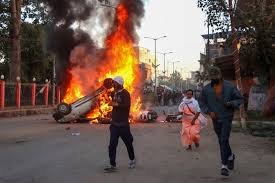Questions are being raised about security policies in Kashmir after a devastating attack in the isolated Baisaran meadow. The lack of security, coupled with the hour-long trek from Pahalgam, allowed terrorists to operate with impunity, raising concerns about prioritizing normalcy over safety.
BY PC Bureau
April 23, 2025:
The brutal terror attack that claimed 26 lives in the picturesque Baisaran meadow near Pahalgam on April 22 has laid bare the deadly combination of non-existent security and the area’s daunting inaccessibility.
Nestled approximately six kilometers uphill from the main town of Pahalgam in the Anantnag district of Jammu and Kashmir, the popular tourist spot, often lauded as “mini-Switzerland” for its breathtaking scenery, tragically became a death trap for unsuspecting visitors. 1
Eyewitness accounts and initial reports paint a grim picture of terrorists operating with impunity, their actions facilitated by the remote location and the conspicuous lack of any security presence.. This absence of protection, compounded by the arduous journey required to reach the meadow, effectively rendered the tourists “sitting ducks,” allowing the attackers to execute their brutal plan without immediate threat of intervention.
Enveloped by pine-covered ridges, the Baisaran meadow’s unique location renders it inaccessible by direct road. Tourists and locals typically rely on either a significant uphill trek on foot or hiring ponies to navigate the hilly and often steep terrain. This inherent difficulty in reaching the area proved to be a critical factor that played directly into the hands of the terrorists.
ALSO READ: X Users Claim Pak Deploys Military Assets Near J&K After Terror Attack
Delayed Security Response: The challenging terrain and the considerable six-kilometer distance from Pahalgam town significantly hampered the response time of security forces. It would take at least an hour for personnel to reach the site on foot, a critical delay the terrorists were acutely aware of and ruthlessly exploited. This lag provided them ample time to carry out their heinous act and make their escape before any effective counter-offensive could be launched.
Easy Targe ( Sitting Ducks)
Approx 2500 Tourist visit this place every day during season .
If the leadership thinks that such a easy and vulnerable Target won’t be attacked ,then for sure introspection is required at all levels. pic.twitter.com/C17Z10DQx1
— Indigenous (@captsinghjs) April 23, 2025
Logistical Nightmares for Evacuation: The inaccessibility also created immense difficulties in evacuating the injured. Initial reports detailed the urgent deployment of helicopters to airlift the critically wounded, while locals desperately resorted to using ponies to bring some victims down the treacherous paths to Pahalgam. This underscores the severe logistical challenges posed by the terrain in the aftermath of the attack, potentially costing precious time in providing crucial medical aid.
Sense of Isolation and Facilitated Escape: The relative isolation of Baisaran likely contributed to a heightened sense of vulnerability among the tourists, making it exceedingly difficult for them to seek immediate assistance or find viable avenues of escape. Furthermore, the surrounding dense forested and rugged hilly landscape provided the terrorists with ideal escape routes, allowing them to melt away into the foliage before security forces could effectively cordon off the area. By the time security personnel finally reached the scene, the attackers had already vanished into the surrounding wilderness.
Questions Raised Over Security Policy: The glaring lack of security cover in Baisaran might be linked to a deliberate policy by the state administration aimed at projecting an image of normalcy in the Kashmir Valley following the abrogation of Article 370. This policy reportedly extended to the recent opening of nearly 75 previously restricted tourist locations across the valley, seemingly prioritizing increased tourist footfall over robust security measures in remote areas.
, in a post on April 22, 2025, expressed dismay, stating, “There were 2000 tourists in the meadows of Baisaran valley and not a single security personnel was present on the spot. Why is no one questioning the security lapse to the authorities?” The user also alleged that when a reporter raised the issue on a news channel, the live feed was abruptly cut, hinting at attempts to suppress discussion.
Security agencies have indicated that the attackers may have infiltrated through the porous Kishtwar-Kokernag route. In response, a massive anti-militant operation has been launched, with army, CRPF, and police personnel fanning out across the extensive area. Drones and sniffer dogs are being actively deployed to comb the thick forest zone in pursuit of the perpetrators.
The ease with which the terrorists executed their deadly plan and subsequently escaped into the forests has ignited serious concerns and prompted urgent questions regarding the adequacy of security protocols for tourists visiting remote and less accessible areas in the Kashmir Valley. The tragic events in Baisaran serve as a stark reminder of the extreme vulnerabilities created by the absence of security. While investigations are actively underway, the authorities will have to explain the rationale behind leaving such a popular tourist destination without any security presence, a lapse that ultimately contributed to the catastrophic loss of life.













